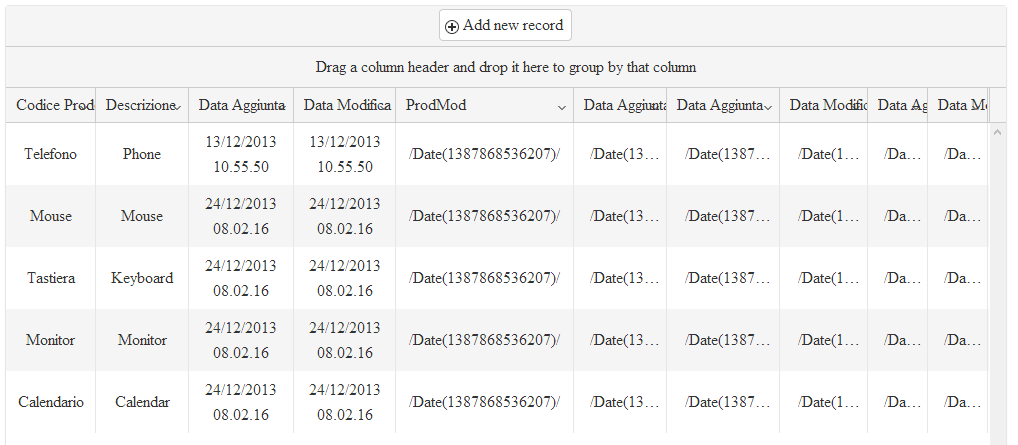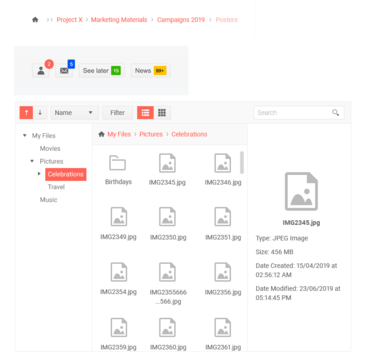Stainless steel 6.2 download. You can scale the date axis of your ASP.NET MVC Bar Chart to get a better visualization of the seasonal data in your app. This can be done by modifying: The base date unit of the x-axis through the CategoryAxis.BaseUnit method, which takes seconds, minutes, hours, days, week, months and years. The default aggregates of the series through the Series.Aggregate property, which takes max, min, sum, avg and count. I have a telerik grid with a dynamic data source (the grid may use up to roughly 10 totally different models for its data), so I have to build the columns dynamically as well (obviously). One of the columns in the grid (with certain models) is a double representing a time span in milliseconds. In order to format some data based on column type, you need to use the properties of the respective column. 80s greatest hits zip. GridBoundColumn. for example has DataFormatString property that you can use to format the appearance of the data in the cells of that column.The formatting is based on the general formatting rules in.NET, i.e. Telerik RadGrid.uses.



The table below shows a list of the standard format characters. For each standard pattern, it shows the pattern from the current CultureInfo settings that the pattern represents. The format characters are case-sensitive, for example, 'f' and 'F' represent different patterns.
| Format Character | Description |
|---|---|
| d | Short date pattern |
| D | Long date pattern |
| f | Full date and time (long date and short time) |
| F | Full date time pattern (long date and long time) |
| g | General (short date and short time) |
| G | General (short date and long time) |
| m, M | Month day pattern |
| r, R | RFC1123 pattern |
| s | Sortable date time pattern (based on ISO 8601) using local time |
| t | Short time pattern |
| T | Long time pattern |
| y | Month year pattern |
Kendo Mvc Grid Column Template
The table below shows a list of patterns that can be combined to create date format patterns.The patterns are case-sensitive; for example, 'MM' is recognized, but 'mm' is not. If the date format pattern contains white-space characters or characters enclosed in single quotation marks, the formatted string will also contain those characters. Characters not defined as part of a format pattern or as format characters are reproduced literally.
Kendo Mvc Grid Date Format

The table below shows a list of the standard format characters. For each standard pattern, it shows the pattern from the current CultureInfo settings that the pattern represents. The format characters are case-sensitive, for example, 'f' and 'F' represent different patterns.
| Format Character | Description |
|---|---|
| d | Short date pattern |
| D | Long date pattern |
| f | Full date and time (long date and short time) |
| F | Full date time pattern (long date and long time) |
| g | General (short date and short time) |
| G | General (short date and long time) |
| m, M | Month day pattern |
| r, R | RFC1123 pattern |
| s | Sortable date time pattern (based on ISO 8601) using local time |
| t | Short time pattern |
| T | Long time pattern |
| y | Month year pattern |
Kendo Mvc Grid Column Template
The table below shows a list of patterns that can be combined to create date format patterns.The patterns are case-sensitive; for example, 'MM' is recognized, but 'mm' is not. If the date format pattern contains white-space characters or characters enclosed in single quotation marks, the formatted string will also contain those characters. Characters not defined as part of a format pattern or as format characters are reproduced literally.
Kendo Mvc Grid Date Format
Telerik Mvc Grid Date Format
| Format Pattern | Description |
|---|---|
| d | The day of the month. Single-digit days have no leading zero. (Only if used in the context of a longer pattern. A single 'd' on its own represents the Short date pattern.) |
| dd | The day of the month. Single-digit days have a leading zero. |
| ddd | The abbreviated name of the day of the week. |
| dddd | The full name of the day of the week. |
| M | The numeric month. Single-digit months have no leading zero. (Only if used in the context of a longer pattern. A single 'M' on its own represents the Month day pattern.) |
| MM | The numeric month. Single-digit months have a leading zero. |
| MMM | The abbreviated name of the month. |
| MMMM | The full name of the month. |
| y | The year without the century. If the year without the century is less than 10, with no leading zero. (Only if used in the context of a longer pattern. A single 'y' on its own represents the Month year pattern.) |
| yy | the year without the century. If the year without the century is less than 10, with a leading zero. |
| yyyy | The year in four digits, including the century. |
| gg | The period or era (e.g. 'A.D.'). This pattern is ignored if the date to be formatted does not have an associated period or era. |
| h | The hour in a 12-hour clock. Single-digit hours have no leading zero. |
| hh | The hour in a 12-hour clock. Single-digit hours have a leading zero. |
| H | The hour in a 24-hour clock. Single-digit hours have no leading zero. |
| HH | The hour in a 24-hour clock. Single-digit hours have a leading zero. |
| m | The minute. Single-digit minutes have no leading zero. (Only if used in the context of a longer pattern. A single 'm' on its own represents the Month day pattern) |
| mm | The minute. Single-digit minutes have a leading zero. |
| s | The second. Single-digit seconds have no leading zero. (Only if used in the context of a longer pattern. A single 's' on its own represents the sortable time pattern.) |
| ss | The second. Single-digit seconds have a leading zero. |
| t | The first character in the AM/PM designator. (Only if used in the context of a longer pattern. A single 't' on its own represents the short time pattern.) |
| tt | The AM/PM designator. |
| / | The '/' custom format specifier represents the date separator, which is used to differentiate years, months, and days. For using '/' as separator you need to espace it (for example 'yyyy/MM/dd') |
